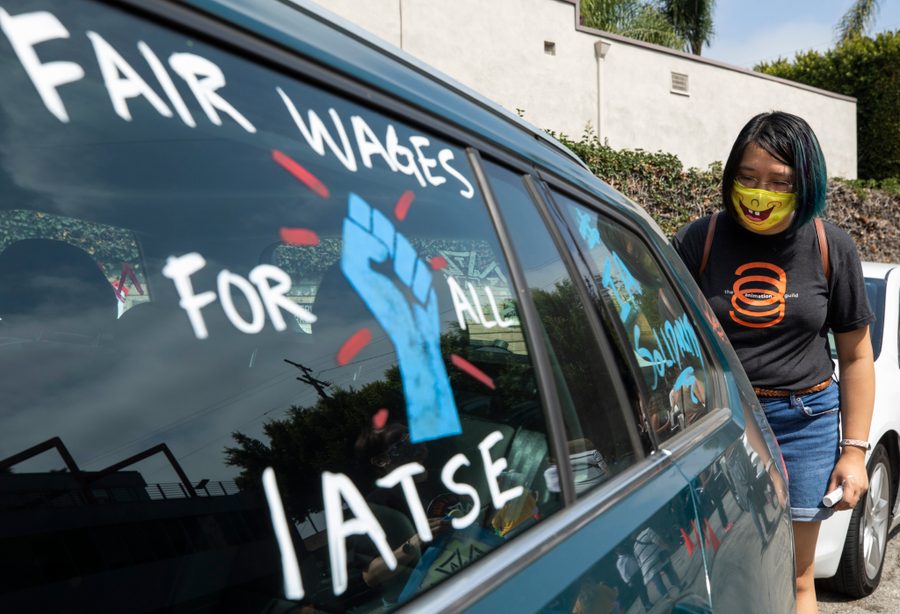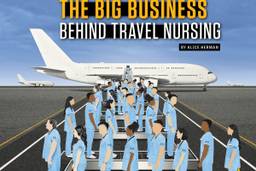IATSE Entertainment Workers Are on the Verge of Their First National Strike
Workers are targeting the streaming industry, which has profited massively during the pandemic.
Alice Herman

On Monday, the International Alliance of Theatrical Stage Employees (IATSE), the union representing behind-the-scenes entertainment workers, reported that members voted by a margin of 98 percent—with 90 percent turnout — to authorize a strike.
The near-unanimous vote follows a stall in contract negotiations between the union and the Alliance of Motion Picture and Television Producers (AMPTP) over hours, pay and other issues, including provisions that would penalize employers from withholding lunch breaks. If the union ultimately goes on strike, up to 60,000 workers could walk off the job, which would represent the largest strike in IATSE history — and their first nationwide strike in the union’s 128-year history. The workers would also be challenging tech behemoths like Hulu, Amazon and Apple, which have profited from skyrocketing demand for internet streaming services during the pandemic.
Workers say that many behind-the-scenes craft jobs on television and movie sets are demanding and thankless. A set decorator at Disney, who spoke to In These Times on the condition of anonymity due to fear of retaliation, described a job she had last year that required her to report for work for stretches of 12 days at a time for as long as 22 hours a day. When the pandemic brought production to a temporary halt, she says, she was grateful for the break. As production companies instituted Covid-19 guidelines and began to reopen, though, the pace of work only increased. “[What] was always going through my head,” she says, “is just ‘Wow, I remember when I had time, and I could sleep, and I could finish a book, or I could walk my dog, or I could see a friend or talk to my family on the phone even.’”
Her situation, while extreme, is not unique. In the last month, union and non-union entertainment workers have testified on social media to their grueling and abusive working conditions — a demonstration of solidarity and a lesson for outsiders about the reality of work in an industry associated with luxury and wealth.
“[People] think it’s the land of dreams and honey,” says John Cantú, a trailer editor at Universal Pictures and a member of IATSE Local 700, the Motion Picture Editors Guild. “No, this is labor…at the end of the day it is physical, hard work.” As an editor, Cantú is spared the grueling physical demands that on-set workers face. But he supports IATSE as it ramps up towards a strike, noting the protections and benefits he says the union affords him in his job. “Being in the union, having reasonable hours, being properly compensated, competitively — that’s made me a better editor,” says Cantú. “I’ve got more dignity, I take more pride in my work.”
In addition to provisions for lunch breaks and a minimum 10-hour “turnaround” time between shifts for union and non-union workers, IATSE is fighting for a heftier percentage of residuals from streaming services — which would help fund union pensions and healthcare. Historically, producers have been required to pay both actors and the union a portion of the profits when a show or movie is re-run or released on a secondary media, like DVD. But as television and movies are increasingly relegated to streaming services, those payments have slowed. In the 2009 contract, IATSE agreed to “greater flexibility” in terms of pay and residuals for “new media” companies like Netflix, calling the ventures “exploratory” and, thus, riskier and potentially unprofitable.
Today, the union argues, “New Media is now the industry standard and growing exponentially. This is not just about streaming companies — among the most valuable corporations on the planet — but also about the studios and networks where our members’ labor facilitated their ability to compete and succeed. New media is now just media.”
AMPTP did not immediately respond to a request for comment.
During the Covid-19 pandemic, demand for at-home entertainment accelerated, and the companies providing subscription access to television and movies have cashed in on that entertainment model. By the end of 2020, subscriptions to streaming services reached over 300 million in the United States alone — a 32 percent increase from 2019. According to the Motion Picture Association, a trade organization, the so-called “home entertainment” market netted $30 billion in revenue in the United States. And the companies that own those services are among the most profitable in the world, with Amazon alone valued at $1.7 trillion.
In a high-profile battle over the financial relationship between “new media” and workers, actress Scarlett Johansson sued Disney in July after the company decided to release the film Black Widow simultaneously in theaters and on Disney+, the company’s streaming platform. In September, Johansson reportedly won $40 million in an agreement with Disney. Whether IATSE members will also be able to win a fair share of the highly-profitable streaming ventures depends on the outcome of the ongoing negotiations — and the possibility of a strike.
“To me, that’s the biggest philosophical issue of the strike,” says Cantú. “What are people entitled to?”
Alice Herman is a journalist covering politics and labor in the Midwest. She is a contributing reporter at the Guardian US and a former investigative reporting fellow with In These Times.





